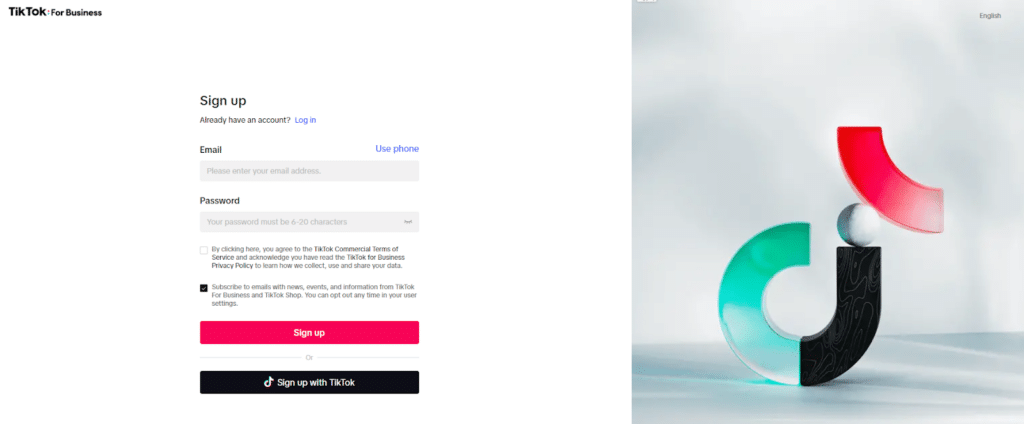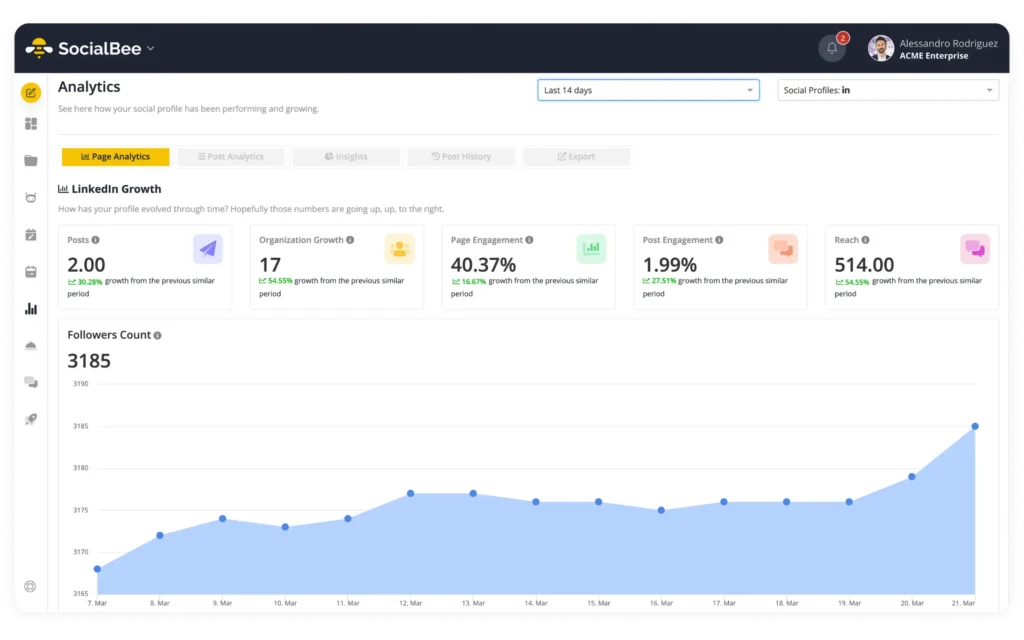
Guest Author
Are you ready to unlock the TikTok’s sales potential but don’t know where to start?
TikTok is one of the most powerful social platforms when it comes to driving sales. Compared to other media channels, TikTok users are 1.7x more likely to discover, 1.4x more likely to consider, and 1.4x more likely to purchase a product they discover on the app.
Additionally, a whopping 77.5% of users on TikTok are younger than 34 years old, making it an essential app for brands to reach the Millennial and Gen Z demographics via ads.
However, learning the ropes of TikTok to create engaging ads that drive sales can be challenging. In this article, we’ll look at the broad steps to create effective TikTok ads and some best practices to keep your workflow efficient.
Ready to find out more about TikTok ads?
Streamline your marketing with an efficient social media strategy template.
Short Summary
- Before diving into paid TikTok ads, it’s crucial to establish a solid organic presence on the platform. Successful brands on TikTok often blend their paid advertising efforts with strong organic content.
- A fundamental step in launching TikTok ads is setting up an Ads Manager account on the platform. This account allows brands to understand TikTok’s unique environment.
- The process of starting your first ad campaign on TikTok involves strategic planning to ensure your ads resonate with the TikTok community.
- Adhering to TikTok’s recommended ad specifications, such as the preferred 9:16 vertical aspect ratio and a resolution of at least 720p, is vital for maximizing ROI. Short-form video content, typically between 15-30 seconds, is encouraged to match the viewing habits of TikTok users.
- Continuous monitoring and optimization of your TikTok ad campaigns are essential for success. Utilizing insights from performance data allows brands to refine their advertising strategies.
Table of Contents
- First Things First: Balance TikTok Ads with Organic Content
- Setting Up a TikTok Ads Manager Account
- Creating Your First Ad Campaign
- TikTok Ad Specs and Creative Guidelines
- What Are the Different Types of TikTok Ads?
- How to Target and Choose Your Audience
- Budgeting and Bidding Strategies
- Monitoring and Measuring Ad Performance
- Tips for Effective TikTok Advertising
- Frequently Asked Questions
- Ready to Embrace TikTok Advertising?
First Things First: Balance TikTok Ads with Organic Content
It’s important to remember that paid social media always works best when it complements your brand’s organic content.
With the right content plan in place, you can start compiling views and authority on TikTok. It can in fact significantly reduce your reliance on paid advertising.
For example, when Olly, a vitamins and supplements company, wanted to get started with a presence on TikTok, they decided to go big. The team collaborated with some 90 influencers via the Popular Pays platform from Lightricks, yielding 1 million video views, and 18.5% engagement.
Popular Pays is noteworthy in this context because marketers can use it to engage with TikTok influencers on a sponsored content basis, but also to commission video content to use as brand assets in ad campaigns.
They also implemented a well-defined organic content strategy on TikTok, ensuring their page was rich with engaging material. This approach was carefully designed to captivate and retain the audience’s attention, fostering organic reach and interaction.
Craft Your TikTok Strategy with SocialBee!
For brands looking to streamline this process and enhance their strategic planning, SocialBee is an AI-powered social media management platform that offers a comprehensive suite of tools.
Discover the difference a well-orchestrated TikTok strategy can make!
SocialBee excels in social media scheduling, content batching, and recycling, which are particularly valuable for maintaining a consistent posting schedule on TikTok. These features ensure that your content not only aligns with your brand’s goals but also resonates with your target audience.
Setting Up a TikTok Ads Manager Account
A TikTok Ads Manager account will help you understand the platform’s potential, as you explore various business features and functionalities.
Consequently, you will learn what kind of content resonates with your audience, trending post formats, and the casual, creative spirit that defines the culture of the platform.
Here are the steps you need to take to set up a TikTok Ads Manager account:
- Visit TikTok for business: Start by heading to TikTok for Business website.
- Fill in brand details: Provide all the necessary details about your brand as prompted.
- Follow on-screen instructions: Complete the TikTok ad account creation process by following the on-screen instructions.
- Verify your business (optional): Consider verifying your business to add a layer of authenticity, which can lead to increased trust among your TikTok audience.
After creating your account, if you haven’t already, it’s a good idea to spend some time engaging with the community, browsing different hashtags, and consuming content from other brands and creators to expand your learning.
Moreover, it is also a great idea to familiarize yourself with the creative tools that can help give your ads a polished look.
Creating Your First Ad Campaign
Starting your first advertising campaign on TikTok involves a sequence of strategic steps to effectively introduce your brand to the vibrant TikTok community. By following a detailed plan, you can craft campaigns that resonate with your audience and meets your marketing goals.
Here’s how to create a TikTok ad campaign:
- Access the campaign tab: Navigate to your TikTok Ads Manager dashboard, locate the “Campaign” tab, and click on the “Create” button. This action initiates the process for your first sponsored marketing campaign.
- Select your campaign objective: Define what you want to achieve with your campaign. Your objective can range from increasing brand awareness, driving traffic or video views (consideration), to boosting app downloads (conversion).
- Set up ad groups: Ad groups are crucial for organizing your campaign. They allow you to specify:
- Target audience: Who you want to reach with your video ads.
- Budget and schedule: How much you’re willing to spend and the duration of your ad campaign.
- Ad placements: Where your ads will be shown. Starting with “Automatic Placements” is recommended for newcomers, as it leverages TikTok’s algorithm to optimize ad placement.
- Ad creative and text: Begin with creating your ad content. Focus on crafting engaging video ads complemented by compelling ad text that aligns with your marketing goals.
- Budgeting and testing: Opt for a modest budget initially. Experiment with different ad creatives and setups within your ad groups to discover what works best. This testing phase is key to understanding the most effective strategies for your brand on TikTok. Worry not, we’ll provide you with more details about budgeting in a moment!
By adhering to these steps, you lay a solid foundation for your advertising efforts on TikTok, setting the stage for successful campaigns that captivate and engage your intended audience.
TikTok Ad Specs and Creative Guidelines
Ad specifications refer to certain technical parameters, such as aspect ratio and resolution that tangibly describe your creatives. Brands adhering to the recommended specs for all of the parameters have a higher chance of increasing their ROI.
Here are some specific guidelines for Tiktok ads:
- Aspect ratio: TikTok supports various aspect ratios such as 1:1 (square) and 16:9 (horizontal), but the 9:16 (vertical ratio) is usually the best for matching the viewing experience that audiences are used to on the app.
- Resolution: The minimum resolution is 720p, but you can go for 1080p or even 4K to make your videos appear clearer and improve engagement.
- File Type: This depends on personal preference, as TikTok supports a wide range of common formats, including MP4, MOV, MPEG, and AVI.
- Video Length: As short-form content is the standard on TikTok, investing in 15-30-second clips for promoting your brand and its offerings can give you better results. The allowed range for TikTok ads is 5-60 seconds.
TikTok is known for encouraging its users to push their creative boundaries to share their stories, experiences, and views in entertaining and authentic ways. It is crucial for brands to keep this in mind while running ads.
Apart from using creative tools to add captivating filters and music, you can leverage user-generated content (UGC) to increase community participation, experiment with different ad formats such as in-feed ads and branded hashtags, and focus on taking your audience on an emotional journey that will bring them closer to your brand.
What Are the Different Types of TikTok Ads?
TikTok offers a diverse range of advertising options, catering to various marketing objectives and creative strategies.
Here’s a closer look at the types of TikTok ads available to advertisers:
- In-Feed Ads: Seamlessly integrated within the “For You” page, these ads offer native advertising that supports actions like app downloads or website visits.
- Spark Ads: Amplify existing organic content by turning it into sponsored content, enhancing authenticity and engagement.
- TopView Ads: Appear first upon opening the TikTok app, full-screen and with sound, capturing immediate attention for up to 60 seconds.
- Brand Takeover Ads: Full-screen ads that appear when TikTok is opened, providing high-impact visibility with options for static images, GIFs, or videos.
- Branded Hashtag Challenge Ads: Encourage creation of user-generated content around a branded hashtag, featured on TikTok’s discovery page to boost engagement and virality.
- Carousel Ads: Display multiple images in one ad, each with a unique link, ideal for showcasing different products or telling a story.
- Branded Effect Ads: Allow creation of custom interactive filters and effects for users to apply in their videos, enhancing brand engagement.
- Pangle Ads: Extend the reach of TikTok campaigns to other mobile apps, targeting a broader audience outside of TikTok.
1. In-Feed Ads
These ads appear within the user’s “For You” page, integrating seamlessly with other content. They offer a native advertising experience, supporting various calls-to-action like app downloads, website visits, or promoting a hashtag challenge.
For example, this is how Classpass is advertising its free trial:
In-Feed ads are designed to engage users as they scroll through their feeds, providing a direct interaction point.
2. Spark Ads
Spark ads enable brands to amplify existing organic content, either from their own account or from other users (with permission), by turning it into sponsored content. This format feels more authentic and native to the platform, which can lead to higher engagement rates.
Here’s such an example of spark ad:
Spark ads are ideal for brands looking to leverage the power of organic content within their paid campaigns.
3. TopView Ads
These ads offer prime visibility as they are the first thing a user sees upon opening the TikTok app.
For example, here’s such an ad from Revolut that just appears on your for you page when opening the app:
TopView ads are full-screen, sound-on, and can last up to 60 seconds, making them highly impactful for capturing attention and delivering immersive brand messages.
4. Brand Takeover Ads
Brand Takeover ads are full-screen ads that appear when users first open TikTok, offering a similar level of prominence as TopView ads but are typically shorter in duration.
These ads can be static images, GIFs, or videos and often include a link to a website or TikTok page. They’re designed for high-impact visibility and immediate attention.
5. Branded Hashtag Challenge Ad
These ads invite users to create content around a branded hashtag, fostering user-generated content and widespread engagement. Branded Hashtag Challenge ads are featured on TikTok’s discovery page, encouraging participation and virality.
The #readySETgo hashtag challenge by Laura Mercier is a great example of such ads:
This format is highly effective for boosting brand awareness and engagement through interactive, community-driven content.
6. Carousel Ads
Carousel ads enable advertisers to display multiple images within a single ad unit, each image having its own link. This format is especially beneficial for brands looking to showcase various product features or to narrate a story through a series of images.
Here’s such an example of carousel ads:
Carousel ads offer a dynamic way to engage users with more depth and narrative than single-image ads.
7. Branded Effect Ads
Branded effect ads allow advertisers to create custom interactive filters, effects, and stickers that users can apply to their own videos. These ads encourage creative participation, enabling users to interact with the brand in a fun and engaging way.
Here’s such an example of a branded effect ad from Fenty:
Branded effects can significantly enhance brand visibility and user engagement by integrating brand elements into user-generated content.
8. Pangle Ads
As part of TikTok’s advertising network, Pangle focuses on delivering ads within mobile applications outside of TikTok itself. This approach extends the reach of TikTok advertising campaigns to a wider audience across different apps, enhancing the potential for engagement beyond the TikTok platform.
Here’s an example of a Pangle ad in a game:
Source: TikTok
Pangle ads are a strategic choice for advertisers aiming to tap into a broader user base.
How to Target and Choose Your Audience
Not everyone on TikTok will be interested in your brand and its offerings, so not everyone should see your ads. Showing ads only to relevant people not only increases the efficacy of your campaigns but also keeps your costs low.
TikTok helps brands reach their target audience based on demographics (age, location, language), interests and behaviors (hashtags followed, categories of videos watched, accounts followed), and devices (iOS, Android).
Moreover, it offers advanced options like Smart Targeting that broaden the reach further by broadcasting your ads to groups outside of your designated personas. Of course, you can set limits to this feature based on criteria like cost per action and ad fatigue.
In order to set these targeting parameters to ensure your ads reach the selected audience, it is essential to to have an accurate understanding. You can do so by conducting in-depth market research, analyzing your existing audience data, and monitoring whom your competitors target.
However, checking off all the relevant action items for the above tasks can get resource-intensive and delay your TikTok ad campaign.
HypeAuditor utilizes machine learning to give you insights into your audience’s preferences, enabling you to create better ads on TikTok. The tool considers various metrics such as engagement rate, audience demographics, and follower growth to inform you which subset of TikTok users will find your brands’ offerings most relevant.
Budgeting and Bidding Strategies
TikTok sets minimum budget requirements to encourage brands and advertisers to invest a base amount in sponsored videos, aiming for tangible outcomes. Specifically, each ad group must have a daily budget of at least $20, and the overall campaign must allocate a minimum of $50.
To improve the chances of getting better results, it’s a good idea to bid strategically for specific goals such as maximizing views, interactions, or clicks to help TikTok show their ads to more relevant users.
Bidding strategies for TikTok advertisers include:
- Cost per view (CPV): Is charged every time your video is viewed. This model is ideal for advertisers focused on video views.
- Cost per mille (CPM): Is the cost per thousand impressions, making it suitable for those aiming to maximize brand exposure.
- Optimized cost per mille (oCPM): Optimizes ad delivery to reach people most likely to take the desired action, balancing reach and engagement cost-effectively.
- Cost per click (CPC): Charges advertisers each time their ad is clicked, preferred for driving direct responses or actions.
While selecting a bidding strategy, it is essential to be mindful of your campaign budget, as some bidding strategies such as CPV require a higher budget compared to the other ones.
Monitoring and Measuring Ad Performance
Running various ad campaigns on TikTok with in-house and influencer content can be hard on your budget. Hence, it is crucial for you to track how your audience perceives your messages so you can iteratively refine your approach to TikTok ads.
Here are the TikTok ad performance metrics you should focus on:
- Impressions: Measures the total number of times your ads were displayed to users. This metric helps gauge the reach of your campaign.
- Clicks: Counts how many times users have clicked on your ad. This indicates the level of interest or engagement with the content of your ad.
- Click-through rate (CTR): Calculates the percentage of impressions that resulted in a click. CTR is a key metric for assessing the effectiveness of your ad in compelling users to take action.
- Conversions: Tracks the number of users who completed a desired action (such as making a purchase, signing up, or downloading an app) after clicking on your ad. This metric is crucial for understanding the actual impact of your ad on your business goals.
- Conversion rate: The percentage of clicks that resulted in a conversion. This indicates how effectively your ad drives users to complete the desired action.
- Cost per click (CPC): The average cost for each click on your ad. This metric helps manage your ad budget efficiently and evaluate the cost-effectiveness of your campaign.
- Cost per impression (CPM): The cost for every thousand impressions of your ad. This metric is useful for understanding the cost of reaching a large audience.
- Cost per conversion: The average cost of each conversion achieved through your ad campaign. This metric is vital for assessing the financial efficiency of your advertising efforts.
- Engagement rate: Measures the level of engagement (likes, comments, shares) your ad receives. This metric provides insight into how compelling and relevant your content is to your target audience.
- Video view rate: For video ads, this metric tracks the percentage of viewers who watched your video for a specific duration or completed the view. It’s essential for evaluating the effectiveness of your video content.
- Return on ad spend (ROAS): Measures the total revenue generated from your ad campaign compared to the cost of the ads. ROAS is crucial for evaluating the overall profitability of your advertising efforts.
After monitoring your own ad performance, it’s crucial to extend your analysis to include competitor’s ad strategies. Utilizing a TikTok AdSpy tool like BigSpy can be invaluable. BigSpy offers insights into competitors’ ad strategies, including impression, popularity, engagement rates, audience analysis and so on. Understanding these metrics helps you identify successful tactics in your industry and apply them to your own campaigns. Additionally, it uncovers gaps in your approach and inspires new ideas. Overall, BigSpy provides the data-driven insights needed to make informed decisions and stay ahead in the competitive TikTok ads landscape.
Tips for Effective TikTok Advertising
To ensure your brand stands out on TikTok, it’s crucial to harness the platform’s unique culture and user behavior.
Here’s a short list of tips for effective TikTok advertising:
- Embrace TikTok’s creative culture: TikTok users often value authentic, genuine, and relatable content that evokes positive emotions. To do so, keep an eye on recent TikTok trends, and feel free to incorporate humor and fun elements into your ads.
- Focus on visual storytelling: Narratives built around your brand’s values and offerings increase message recall and brand affinity. Use high-quality visuals, preferably UGC, to make your stories more compelling and emotional.
- Use sound wisely: You only have the attention of your viewer for a few seconds and using catchy music will help enhance your message to make the most out of those few seconds.
- Keep the call to action (CTA) clear: Tell your audience exactly what they need to do, whether it is liking a video, following an account, or signing up for a service. This will take the vagueness away of your message.
- Encourage community engagement: Respond to comments on your ads and engage with fellow users to encourage your audience to interact with your ads. It can also be beneficial to create shareable content and nudge your viewers to share it.
- Target your audience precisely: As mentioned above, running programmatic ads on TikTok can get resource-intensive, making it essential for brands to reach high-intent viewers to get the bang for their buck.
- Measure and optimize: Based on the objectives of your TikTok ad campaign, monitor the performance metrics closely and make changes as needed proactively. Experiment with different types of content, CTAs, targeting parameters, and so forth, to find the perfect formula.
- Keep an eye on your organic content: It’s extremely important to know what’s your best-performing organic content, so you can adapt your ads accordingly. Thankfully, with SocialBee’s AI-powered social media management platform, you can monitor your best-performing TikTok videos.
Discover the content types with the most engagement from SocialBee.
Start your 14-day free trial today!
Here are the metrics and audience insights you can track with SocialBee:
- Demographics: Dive into your audience’s demographics to understand the age, gender, country, and language distribution of your page’s followers.
- Follower growth: Track the pace at which your audience is expanding across each platform. This insight helps pinpoint where to concentrate efforts for further refinement.
- Top-performing posts and categories: Identify which posts, categories, and post formats yield the best results, informing your content strategy to maximize engagement.
- Engagement and reach: Stay updated on your social reach and engagement metrics. Identifying your best posts allows for pinpointing what aspects of your strategy need tweaking.
Armed with this data, you can fine-tune your advertising efforts to mirror the success of your organic content. For example, if you notice that tutorial videos or humorous content tend to garner the most likes, comments, and shares, you can adapt your ad campaigns to feature similar themes and formats.
Frequently Asked Questions
TikTok ads cost at minimum USD 50 per day, and the minimum ad group-level budget is USD 20 per day. Your overall budget will depend on factors like bid amount, ad type, and audience targeting.
Yes, TikTok ads are still worth it. They offer access to a vast, engaged audience, particularly among younger demographics. Additionally, the platform’s unique format encourages creative, impactful advertising that can significantly enhance brand visibility and engagement.
The audience targeting can get as precise as you want it: you can target users based on device, gender, location, age, and specific interests or behaviors.
TikTok also offers advanced targeting options like lookalike audiences and the ability to target based on user interactions with specific types of content or creators.
Ready to Embrace TikTok Advertising?
After setting up a TikTok ads account, you need to create engaging ad videos that resonate with your audience. But, you can maximize the impact of such campaigns by engaging with the community with organic activity and by partnering with influencers and creators.
Monitoring campaign performance metrics meticulously is also essential, enabling you to fine-tune your strategies based on concrete data. This approach ensures the development of TikTok ad campaigns that not only capture attention but also foster genuine interaction and drive meaningful conversions.
Ready to get started? Start your 14-day SocialBee trial today!

SocialBee: Your AI-powered social media management tool
About the author: Hazel Raoult is a freelance marketing writer and works with PRmention. She has 6+ years of experience in writing about social media, entrepreneurship, and all things SaaS. Hazel loves to split her time between writing, editing, and hanging out with her family.
























 Customizable tone of voice
Customizable tone of voice  Several variations to choose from
Several variations to choose from  1,000 pre-made AI prompts
1,000 pre-made AI prompts